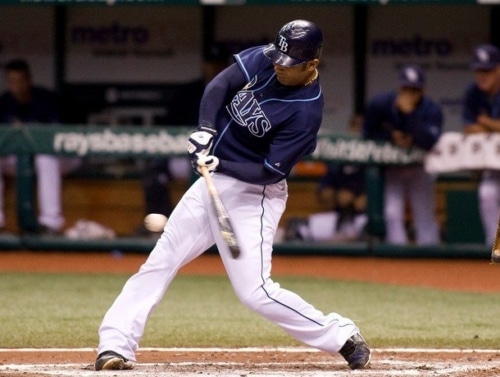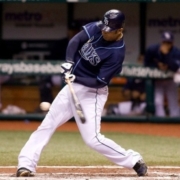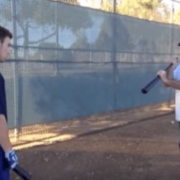At Last, The Secret To Decreasing Strikeouts Is Revealed
The NEW Way Pitchers Are Getting Hitters Out That May Be Hiding Under Your Nose…
Know WHY, according to Baseball-Reference.com, strikeouts (41,207) edged out hits (41,018) in the Big Leagues in 2018? In my opinion, the above MLB Tonight Brian Kenny interview of Trevor Bauer has the answers.

Carlos Pena fouling a ball off in 2009. Photo by J. Meric/Getty Images
Could it be…
- The Launch Angle craze? Maybe…
- Hitters just don’t care about strikeouts anymore? Maybe…
- The front office putting higher value recruiting players based on key Sabermetrics? Maybe.
However, in my opinion, these are all symptoms to the direct cause. Yes, hitters are being taught that ground-balls are gross. And since the book and movie Moneyball came out, Math revealed key metrics measuring how often:
- A hitter gets on base, and
- They hit for extra bases…
…are better predictors to scoring runs. Here’s a shot across the bow for the hitting coaches…
Back to the Trevor Bauer Evolution of Metrics conversation above,
Perry Husband, of HittingIsAGuess.com, has been sharing Effective Velocity principles for almost 2 decades, and it’s finally getting people’s attention. WHY? Because more and more pitchers are starting to apply the timing disruption principles. Unlike golf, timing is a MAJOR factor in how consistently hard a hitter hits the ball. And it’s THIS factor of a hitter’s success that’s under MAJOR attack.
Do you think I’m exaggerating? Read on, because Perry, myself, and many others see the writing on the wall…remember when Wayne Gretzky so famously said, “Skate to where the puck is going, not where it has been.”
I speak to MANY MANY coaches, and a majority of them, are disgusted with the sheer number of offensive strikeouts over the last few years, so their solution is to teach a defensive “just get on base” swing. Are you kidding?! More pitchers are throwing 96-mph+ at the higher levels nowadays, they LOVE facing hitters being taught a defensive “just get on base” swing. And it’s not just at the highest levels, overall average velocities are going up across the board because of better training programs.
And by the way, it’s not about the higher pitching velocities per se, because we can train hitters to see faster speeds in the “lab”, making the increased game velocities “seem” slower. That’s only one-dimension to pitching, as Trevor Bauer puts it in the interview.
It’s what pitchers are being taught to do with added velocity, manipulating hitters’ reaction times. Don’t you see, the game is speeding up for hitters, and coaches are ill equipped to deal with the adjustment right now. They’re running east, chasing a sunset!
Rest assured, we’re going to make a better decision and train differently. Coaches, you’ve been WARNED. In this post, we’ll discuss:
- The NEW way pitchers are getting hitters out, and
- How to counter this strategy…
The NEW Way Pitchers are Getting Hitters Out

Trevor Bauer interview with Brian Kenny of MLB Network. Photo courtesy: MLB Network
Here are my notes on Trevor Bauer’s scouting report on hitters…
- At the 40-second mark, Trevor talks about having a specific “pitch mix”. And he adds that the delivery of that mix is different for every pitcher – how does he utilize it the best. He looks at hitter’s heat map and compares strengths and weaknesses to his “pitch mix” heat map strengths and weaknesses. What gives a pitcher the best chance of being successful?
- At the 2-min, 20-second mark, Brian asks Trevor about pitch sequencing – which pitch should follow the next? Taking away as many “tip-off” cues hitters use. #1: Changing your body (i.e. tilting off while throwing a CB – mechanics have to be consistent). #2: How does the ball come out of the hand – tunneling, hitters can see “up and down” well, but not “side to side”, so he’s trying to minimize the “hump” in his pitches. The more he can hide pitching cues, the later the hitter sees the ball, and the more likely the pitcher wins. Neutral and clean mechanics.
- At the 3-minute, 45-seconds mark, Trevor Bauer talks about starting off his pitches in the middle and let the movement get to the spot he’s trying to hit. He worked on a new pitch to fill a hole in his pitching repertoire – he needed a pitch that could slide to his glove side that didn’t drop like his curveball.
- At the 6-minute, 45-second mark, Brian asks when Trevor is getting hit, what’s the checklist he goes through to get back on track? He feels his speed differentials are off, either he’s throwing too hard or too soft, for example in early 2017 the data said he was throwing too high a percentage of hard stuff – 4/2-seam FB and cutters, and not enough slow with the CB, SL, and Change. Once organized, hitters had a tough time. 3-Dimensional pitching approach: dealing with front to back (differing velos 95 to 85 to 78-mph), left to right (2-seam, 4-seam, cutter, slider), and up to down (4-seam, SL, and CB).
Did you catch that last bullet point? There’s the Holy Grail of pitchers’ scouting reports right there. Other than that, a lot of REALLY good intel in almost 9-mins, so how do hitting coaches counter this gameplan? Take it from a hitter’s point of view, Carlos Pena, who studied under Perry Husband back in 2009, and in the following video, makes a good case to a promising counter-move…
How to Counter this Strategy…
Here are my notes on Carlos Pena’s scouting report on pitchers who use Effective Velocity…
- At the 15-second mark, talks about hunting pitches, addresses the hitting myth of “looking for the ball away and react in”…pick a spot, a speed, and a rhythm to dance to, react within those parameters,
- At the 1-minute mark, looking for ball away and reacting in would work for one maybe two-dimensional pitchers, objective is to make good contact more often, having an EV plan against a pitcher makes hitting “easier”, setting “coordinates” like latitude and longitude, and work within those parameters, having a “blast radius” and only working within those parameters, match the timing to what you’re looking for, helps hitters to lay off stuff, eliminates half to 3/4 of the strike zone when pitchers get pretty good.
- At the 2-minute, 40-second mark, Carlos talks about his struggles at the beginning of 2009, he met Perry Husband, and he ended up leading the league in homers by the end of the season.
- Best Hitting Drills for 8-Year-Olds (2025): Fix Swing Flaws Fast with This MLB-Trusted Youth Baseball System—At-Home, Step-by-Step, and Built for Game-Day Confidence - July 5, 2025
- Best Youth Baseball Hitting Program to Boost Rotational Power Fast—Trusted by MLB’s Rajai Davis & Built on the Catapult Loading System - June 22, 2025
- The #1 Arm Care Program for Youth Baseball: Why Top Travel Coaches Trust Jaeger’s J-Bands & Long Toss Routine to Prevent Injury Fast - June 3, 2025












A combination of how pitchers are pitching and using Analytics..but batters contribute to their ineptitude…mosts batters seem to swing the same way..these 2 factors combine to result in more K’s..
Batters need to alter their swings to make more contact…more like Rod Carew, and tony Gwynn used to do…how many k they have….
also I feel the owners want more HR….
Not sure I agree with Vito. Pitchers are just better today. When pitchers are throwing 99 mph fastballs and 92 mph sliders, the old hit it where it’s pitched and go up the middle approach doesn’t produce enough runs. And even Tony Gwynne would struggle today. With the shifts, hits 10 years ago are now outs. The only reasonable approach is to make your hard contact count by doing damage.
I agree, pitchers are throwing hard, but hitting high velocity can be trained, and I think the hitters you mentioned would have made the necessary adjustments. However, the problem is the more pitchers taking on 3-dimensional pitching as a strategy will and would make all hitters, of all eras, struggle. It takes more discipline and a more precise strategy to battle it.
I agree, the league is encouraging the extreme swing. But here’s the reality, we can have consistent power without sacrificing swing quality. “All around” hitters were more prevalent back in the day. Hitters gotta get back on track, or else it’s going to be a long painful couple of years…in which case, they’ll be forced to make a change.
Joey,
Shifts make hitting today so much more difficult. And I don’t buy the hit it where they ain’t approach. Pitchers typically locate for contact to the shift. I really hope the league slightly restricts shifts.
Also, because pitchers are better today and are using better tactics, the idea of stringing together three singles to score a run doesn’t produce enough runs in the long run.
I absolutely agree Mark 😀
Do you????
Restrictshifts… That’s funny. Perhap people should learn how to hit… what’s next have the amount of 100+mph pitchers a teams have…Let’s point it to us… if your a batter… get better and have them go bad to the drawing board…~DM
DM,
The best hitters in the world are.getting killed by shifts. Instead of trying to hit line drives over the infield, hitters are stuck trying to hit over the shift.
MLB has lowered the height of the mound in the 60s because hitters were getting dominated.
Watch Ethan Small. He varies the timing of his leg raise to throw hitters off.
Another asset a pitcher can use. Hitters better wake up!